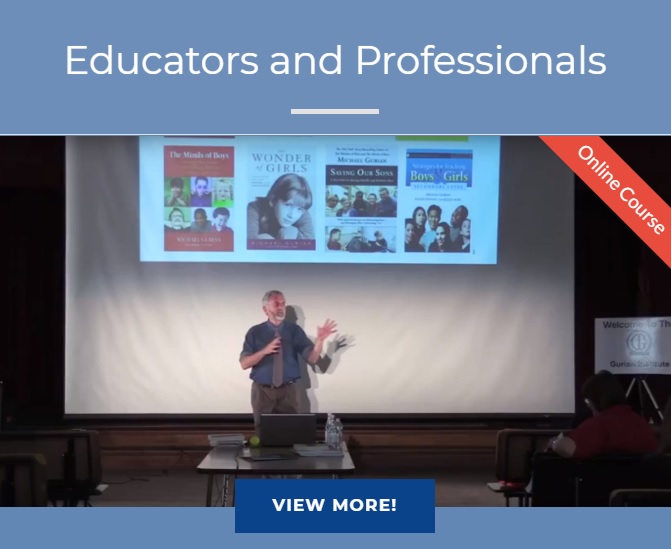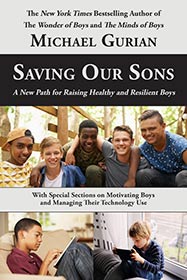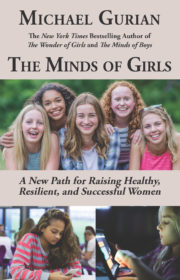
The Minds of Boys – Saving Our Sons from Falling Behind in School and in Life
Monthly Session Plan
(Developed by the Gurian Institute Training Division)
Take the first month of school to read the introduction and the first chapter, and then convene the faculty to begin the book study. No meeting should last longer than one hour. The faculty would be responsible for additional reading each month thereafter in preparation for the book study faculty meeting.
Facilitate optional/differentiated activities for each chapter(s). Groups or individuals should choose at least one activity at each monthly meeting. Some of the options are more involved and take more time. Others are simple and quick to complete, leaving time for the group to select additional activities. By participating in these activities, you will develop skills for implementing similar activities with your students, implementing the important things you learn about nature-based theory and what most helps boys be successful in learning.
Chapter 1 – The Current Crisis
General Discussion Questions: After reviewing, brainstorm examples of how the “male brain” shows up in your classroom. For example: when boys’ brains goes to a “rest state” what happens to their attention in the classroom? What can you do to help?
Activity Option #1
Work individually or as learning teams of 3 to 4 members to review the “Did You Know?” box on page 22. Does your school follow these general trends? Where are you the same? Where are you different? If you don’t know, project what you think your numbers would look like if you analyzed them by gender—then do some research and find out what the numbers are. How close were your estimates? Where were the surprises?
Activity Option #2
Look at the questions on page 26. Share your observations about boys you work with. What patterns emerge as the members of the group share their insights?
Activity Option #3
Brainstorm a list of all the ways parents/families are involved in the life of your school. Come up with a prioritized list of ways to develop more opportunities for parents/families to increase their level of involvement. Choose the top priority and develop an action plan for putting that idea into action.
Chapter 2 – How Boys Learn
General Discussion Questions: How goes gender difference manifest in learning styles? What strategies might you implement in your classroom to make sure boys (and girls) are being engaged in learning?
Activity Option #1
Label a sheet of flip-chart paper “Boy Energy.” Draw a line down the center of the paper. Label the left side “Things That I Enjoy About the Boys In My Class” and the right side “Things That Make My Boys A Challenge.” Brainstorm both sides. After you have the list developed, reflect on how “boy energy” impacts those things that you enjoy and those things that are a challenge. As a group, develop a strategy to address the challenging behaviors. Have group members sign up to “pilot” the strategy and report back to the group on how it goes!
Activity Option #2
Study the brain diagrams on page 47 and the “Did You Know?” box on pages 48-49. Discuss:
· the affect of dopamine on the ability of boys to sit still in a classroom
· how to use the memory function of the hippocampus in helping boys remember facts
· how oxytocin affects learning
· the male brain “rest state” and what it means in the classroom
Activity Option #3
Consider the questions on page 54 about the plasticity of the male brain. As a group, consider how brain science has helped us look at these questions differently, and what the implications are for classrooms based on the information.
Chapter 3 – Helping Boys Before They Begin School
General Discussion Questions: Parents can do a lot to prepare boys for successful educational experiences. Where are the most noticeable gaps in preparation that you see in your classrooms? How can information in this chapter help parents help their children to bridge those gaps?
Activity Option #1
Design an agenda for a one-hour parent meeting for families with children who will be attending your school as new kindergarteners in another year. Plan talk-time and activities to engage the parents. Be specific about what you would say and do during your hour to excite parents about getting their boys (and girls!) ready for school.
Activity #2
Look at the “Ten Strategies To Promote Attachment” on pages 76-78. Have groups of 2-3 choose two strategies and share activities that could be implemented in the classroom to reinforce attachment to the school environment. Be specific! Pool your ideas and promulgate a tool to share with all the faculty and staff of your school.
Activity Option #3
Create an activity, adapting the “Try This” box on page 85 which is an activity for parents, to use in the classroom.
Chapter 4 – Effective Preschool and Early Learning Environments for Boys
General Discussion Questions: What is a boy-friendly learning environment? Does a boy-friendly learning environment create a “girl-unfriendly” learning environment?
Activity Option #1
Do a survey of your classrooms. How boy-friendly are they? What specifically do you see that says “boy friendly?” What do you see that sends the opposite message? What can you do to change it?
Activity Option #2
Design 20 brain breaks that could be used in your school. Make some of them age-appropriate for each level in your school. Print and distribute the brain breaks so all teachers will have them available to try. As teachers develop new brain breaks not on your resource list, collect them and add them to the resource, growing your number as much as possible to provide for lots of variety.
Activity Option #3
In groups of 3-4 create a summary of the main points in Chapter 4. Use a sheet of poster board/paper. Do not use any words! Have each group share their summary with the group.
Chapter 5 – Removing Key Environmental Stressors from Boys’ Lives
General Discussion Questions: Children show up for school every day with much more on their minds than learning. Family and environmental stress can derail the learning process. What kinds of stressors are you regularly seeing in your school/classroom population? Which ones can you truly impact? Which ones do you have to teach around?
Activity Option #1
Our faculty will take on the role of one of the 5 Hat groups described below to look at the impact of screen time (TV, computers, video games). Each group will prepare a presentation given from the point of view of the hat their group is wearing.
White hat group = Data What does the research say?
Yellow hat = Positive What are the positive aspects of these activities? What good could come out of them?
Blue hat = Caution What are the negatives aspects of these activities? What harm could come out of them?
Green hat = Growth What will be learned as result of this information? How can we share this information with parents of our students?
Red hat = Emotion How will each stakeholder group (parents, teachers, children) react to this information?
Activity Option #3
Develop one week of brain-healthy menus, including breakfast, lunch, dinner and two daily snacks.
Chapter 6 – Helping Boys Learn Reading, Writing and Language Arts
General Discussion Questions: What is the “gender gap” in literacy? How does it impact boys’ educational performance? When does it first manifest?
Activity Option #1
Brainstorm a list of skills necessary for boys to have when they start school to help them be successful at learning to read and write. As a group, design a letter to parents containing 6 concrete suggestions on how they can help their boys prepare for their first days of school.
Activity Option #2
Go on a scavenger hunt through your school. Record all the places you see images that encourage boys to enjoy reading and books.
Activity Option #3
Choose four different pieces of music (i.e. jazz, classical, rock, opera), about 5-6 minutes long each. As a group, pick a scene (i.e. beach scene, mountain scene, etc.), a common item (i.e. chair, pencil, book) and a five word phrase (i.e. Watch out for that car!). While playing each piece of music, use your scene, item and phrase to start writing a story.
After all four pieces of music, share your story ideas. Were the stories different depending on the type of music being played? How? Did some music make is easier to write? Did some make it harder? How could you adapt this activity to the classroom?
Chapter 7 – Helping Boys Learn Math and Science
General Discussion Questions: What activities that boys enjoy involve math and science? How can you design content related activities in math and science to include areas of interest to boys?
Activity Option #1
Brainstorm a list of skills necessary for boys to have when they start school to help them be successful at learning to read and write. As a group, design a letter to parents containing 6 concrete suggestions on how they can help their boys prepare for their first days of school.
Activity Option #2
Using online resources, find two dates for each month of the school year that celebrate or commemorate events related to science. In teams of 3-4 choose a month and design a grade-level appropriate boy-friendly lesson plan relating to the calendar events. Each group should write up their activity, including materials needed, and exchange with other groups. Put all the activities in a notebook as a resource for all teachers.
Activity Option #3
Borrow a play book from a middle or high school coach. Using play diagrams in the book, design:
· 5 math problems for students to solve
· 5 science activities related to the sport involved in the play book
Chapter 8 – Using Single Gender Classrooms Effectively
General Discussion Questions: What does the research have to say about the benefits and challenges of single-sex classrooms? Is this really a new idea? What are some of the social issues that arise when schools and communities begin to consider implementation of single-sex classes?
Activity Option #1
Create four debate teams. The teams will be:
· Boys who are in favor of single-gender classes
· Boys who are opposed to single-gender classes
· Girls who are in favor of single-gender classes
· Girls who are opposed to single-gender classes
(“Boys teams” do not have to be all boys—females can role-play when numbers are not in balance.)
Each team will choose a representative to give a 3 minute speech on the team’s position on the issue. Following the presentations have the group debrief on all the issues raised.
Which positions are more or less likely to be present in your community?
Activity Option #2
Using library or online resources, find a story about a school that has implemented single-sex classes. What results did they find? What were the successes? What were the challenges? How long has their project been going? Are they continuing?
Activity Option #3
As a group, develop a proposal that would be a model for a presentation about the potential benefits of incorporating some boy-friendly (and girl-friendly) strategies into your existing classroom structure. Provide appropriate citations for your position.
Chapter 9 – A New Vision if Learning Disabilities, ADD/ADHD, and Behavior Disorders
General Discussion Questions: Do a chapter hunt to answer the following questions:
How many children are diagnosed with ADD/ADHD in a given year?
What percentage of children taking medications for behavioral issues are taking the meds for ADD/ADHD?
What percentage of children diagnosed with ADD/ADHD are boys?
Which chromosome is intrinsically more fragile—the X or the Y?
True or False: Brain scans can accurately diagnose ADD/ADHD.
There are life-style issues that can positively and negatively impact brain health. Discuss the impact of:
Nutrition
Screen time: TV, computers, video games
Exercise
Stress
Chapter 10 – Confronting Undermotivation and Underperformance in Boys’ Learning
General Discussion Questions: There is much concern about boys who are underachievers in our educational system—boys we know are capable and yet seem to have little or no interest in participating in their schooling. Is this a new phenomenon? If not, and boys have always been less than motivated, why are they not doing as well now as they used to? If it is new, what’s changed in the way we educate boys that promotes their lack of motivation?
Activity Option #1
Review the story of Kathy’s two sons on page 245. Brainstorm a list of the boys in your school that are, in your professional opinion, not performing at the level of their ability. How many of them are like Karl? How many like Kevin?
Make a list of factors that they have in common. (Check the “Did You Know” box on page 253 for some ideas) Make a list of factors that seem specific to individual boys. Now brainstorm a list of possible motivation keys to getting them more involved in school.
Chapter 11 – What Parents and Teachers Can Do to Motivate Boys to Learn
General Discussion Questions: What do you think are some of the factors in today’s society that contribute to the problem of undermotivation in our boys? What are some of the challenges to providing some of the solutions in this chapter?
Positive male role models (fathers, grandfathers, mentors)
Nurturing family environments, including extended family
Providing consistent healthy nutrition
Monitoring school work, including homework
Activity Option #1
You have a 16 year old son who is eligible to obtain a driver’s license in your state. Design a contract that will help your son understand that driving is a privilege. Lay out the expectations that will allow him to obtain that privilege. Include school related requirements and any policies you would like to see in place at his school related to driving privileges.
Activity Option #2
Review page Honor Program in the Rites of Passage section on page s 277-278. Design a Rite of Passage in your content area that could become a ritual for all students you teach. Share the Rite of Passage with the group and ask for feedback on how to refine the ritual to make it most meaningful. (These events can be very good for girls too!)
Activity Option #3
Each member of the group should offer one name of a positive adult male that could be invited to make a presentation to boys in the school. The presentation could be about a job, a hobby, travels, career. Build a diverse list and then recruit men to make presentations. Don’t forget senior citizens in your community who have had interesting lives and have much to share!
Chapter 12 – Helping Sensitive Boys in Our Schools
General Discussion Questions: What happens to boys who don’t “fit?” How is a boy’s self-esteem linked to his peer group? What has your school done to provide many diverse ways for boys to be successful?
Summary Activity
Activity Option #1
Walk About Survey
Team members move around the room posing the following questions to as many faculty members as they can in the allotted time. The responses are recorded on a provided form.
Questions:
1. What are three things you recall about what you have learned as a result of our book study?
2. What observations/insight can you make as a result of your learning?
3. How will you apply what you have learned to your work with students?
The form for recording the results of these questions would be a chart titled ‘Walkabout Review’ with three columns with the following headings and room for jotting down responses:
1. Recollections
2. Insights
3. Applications






